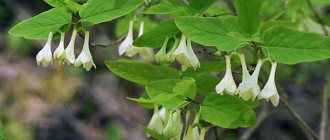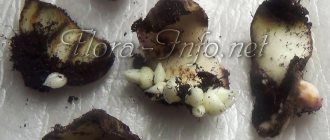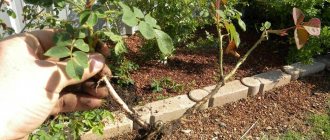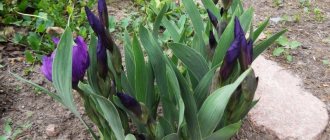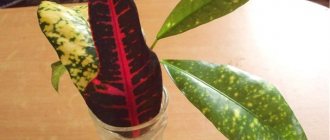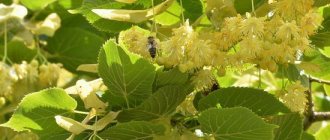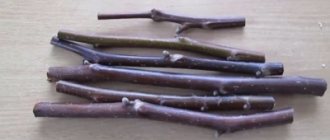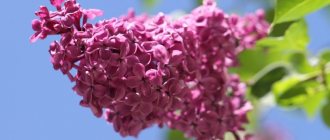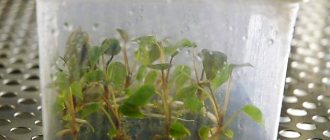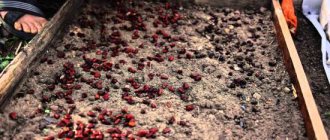When can reproduction be carried out: features
The timing of barberry propagation depends on the chosen method. When cuttings, the procedure is carried out in early spring or, conversely, in the winter. Young branches take root well in greenhouse conditions.
Barberry Thunberg
Dividing the bush is done at the beginning of the season. When the buds begin to swell and the leaves begin to bloom. The leaves will not interfere when dividing the bush. This way you can select the desired piece.
Root shoots appear at the beginning of the season. It takes some of the nutrients from the soil and inhibits the development of the mother bush. It is recommended to remove shoots to make the barberry more luxuriant. But if there is a goal to propagate the plant, then the shoots are left until the end of the season. The procedure begins in the fall.
Propagation of barberry by seeds is a labor-intensive process. The grains are prepared in advance for several months. Layering is done simply. It is advisable at the beginning of the season so that by autumn the new bush can be transplanted to a new location.
It is important to know! The varietal identity is completely transmitted if barberry is propagated by cuttings or shoots.
Methods for propagating barberry
There are several ways to propagate barberry:
- seeds;
- cuttings;
- dividing the bush;
- layering.
In most cases, gardeners prefer to propagate barberry using one of the vegetative methods, because only in this case will the new plants be completely similar to their parents. With the seed (generative) method, they can turn out completely different: with a different shape, shade and pattern of leaves.
In order to decide which barberry propagation method is best for you, we will now take a look at each of them.
Seeds
As a rule, it is believed that the propagation of shrubs and trees by seeds (seeds), i.e. generative way - it is very long and ineffective, because varietal characteristics are most often not preserved when sowing seeds. But not in the case of barberry!
Interesting! Of course, the properties are not 100% preserved, however, in general, new barberry seedlings for the most part repeat the maternal qualities. And barberry grows quite quickly. Therefore, the method is quite effective.
When and where to collect seeds?
At the end of autumn, you can collect seeds (i.e. berries) directly from the bushes of the variety you like.
Of course, you can buy ready-made seeds in a package.
How to plant barberry with seeds:
- Rinse the seeds from the pulp (if you decide to collect the fruits yourself) and dry them, and then store them until the end of winter or beginning of spring.
- In February, place the seeds on artificial stratification (for example, sow them on sand and put them in a closed container under the snow, either in the basement/cellar, or in the refrigerator. But first, soak them in plain water for 2-3 days.
Alternatively, you can sow barberry seeds before winter. Then they will undergo natural stratification and sprout themselves in April-May. However, there is a high probability that the seeds will be eaten by mice.
- Then, in April, when the seeds swell or have already hatched, they are sown in a greenhouse or a little later directly into open ground (for the first time).
But you can also put them in pots first.
- In the fall, you can transplant seedlings from a greenhouse or containers to a permanent place in open ground.
Video: barberry from seeds
Cuttings
Of course, the main advantage of barberry cuttings is the 100% preservation of varietal characteristics.
Barberry can be propagated by both green and lignified cuttings. But often they use the first method, i.e. Cuttings are taken in the summer, not in the fall.
Plant many cuttings at once - at least 5-6. The result will not be 100% in any case.
Green cuttings
Step-by-step instructions for propagating barberry using green cuttings:
- Green cuttings are harvested in the second half of June and early July.
You can use branches cut during summer pruning.
- To do this, take young annual growths: break out cuttings with “heels” (but you can also do without “heels”, just a 10 cm long cutting with 2-3 internodes or 4-5 growth buds, while making an oblique cut from below, and a straight cut from above ).
- Then the lower leaves are completely removed, leaving only a few upper ones (and it is better to leave half of each of them).
- To improve rooting, you can place the lower part of the cuttings for several hours (up to 12 hours) in a solution of one of the root formation stimulants (Kornevin or Heteroauxin) or dip them in dry powder.
- Next, the cuttings are placed in a glass of water for germination (only the lower part of the cutting without leaves should be in the water).
Alternatively, you can root in a glass with sand or soil and perlite, deepening the cuttings at an angle to half their length.
- Next, you need to put the glass in a warm place or make a greenhouse (cover it with film or a bottle).
The optimal temperature for rooting barberry cuttings is +20..+25 degrees.
Do not forget to periodically ventilate and spray the cuttings.
- When, after a few weeks (1 month), roots appear on the lower half of the cutting (when germinating in water, this will be visible, and in a transparent glass with sand, too), it will be possible to plant the cutting immediately in open ground under a greenhouse (bottle). But first, it is advisable to adapt the plant to new conditions by gradually removing the cover and/or taking the container outside for several hours.
Note! Rooted cuttings can be planted in open ground in the fall (September).
Video: barberry cuttings
Propagation by cuttings
It is easier to cut common barberry in summer than in autumn. Thunberg barberry is considered a special variety. It has beautiful flowers and large fruit ovaries. To reproduce, the bush must be no more than 10 years old. After this age, cuttings have difficulty rooting and growing barberry becomes more difficult. How to properly cut barberry?
How to propagate thuja - cuttings and transplantation
It is easy to grow cuttings of ornamental shrubs. The transplant process occurs according to the following algorithm:
- At the beginning of the season, the bush is inspected, young shoots 15-20 cm long are selected. Lignified branches that have 3-4 internodes are also suitable.
- Preparations are made at any time of the year. Planting is carried out mainly in early summer.
- The lower end of the branches is made oblique. This way it will absorb water faster and produce roots.
- If there are leaves, cut them in half.
- On the first day, leave the cuttings in water with the addition of a root formation stimulator.
- Next, the cuttings are transferred to the ground or left in water until the first roots appear.
- If the branches are planted in the ground, they are covered on top with a glass jar or plastic bottle. A greenhouse effect is created inside.
- You can immediately plant the cuttings in a greenhouse.
Additional Information! Without a root formation stimulator, barberry produces roots very slowly.
Cuttings of barberry in summer ensure better survival rate. Winter branches take root worse.
Stages of reproduction
Before cutting barberry, it is important to understand that shoots may not germinate well. Therefore, when propagating shrubs, it is important to adhere to certain stages.
Preparation of material
The most important thing is to properly prepare the planting material. When forming cuttings, the cut where roots will subsequently form is treated with a special substance - a root growth stimulator. The drug is diluted in water according to the instructions and the cuttings are placed in it for 24 hours. Thanks to this procedure, the likelihood of getting good planting material increases.
Choosing a landing site
Since ordinary barberry is considered a heat-loving plant, the place where it will grow should be warm and sunny. It is also important to remember that the shrub does not like excess moisture and swampy soil. Therefore, the area should be well dried, without water accumulation, and have good drainage. It is not recommended to select a place in a lowland, since groundwater usually flows there.
Planting shrubs
After the seedlings appear under the greenhouse, they are transplanted into a separate container. The soil must be well moistened and fertilized. Thanks to fertilizer, green seedlings will quickly grow stronger.
The hole for one seedling should be 45x45 cm in size and 50 cm deep. Such large dimensions are needed in order to transfer drainage and substrate into it without damage. Broken bricks are used as drainage. Then the seedling is placed in the hole, the roots are carefully straightened and covered with earth. At the end, you need to water the bush well and add soil to the place where it settled after watering. The final stage is mulching.
Dividing the bush
Barberry Cobalt - variety description and care
How to properly propagate barberry by dividing the bush? The issue is easily resolved. New bushes quickly take root when:
- They dig up the mother bush.
- They move him to the shade.
- Using scissors, you need to divide the plant into 2 equal halves. At least 3 shoots should come from each daughter barberry.
- 2 holes are dug in the garden. The soil is mixed with fertilizers and well moistened.
- Bushes are planted in a new habitat.
- After 2 weeks, the plants will fully recover.
Barberry in autumn
This method is better for growing young bushes. Digging up a large mature shrub is difficult. During work, you can scratch yourself, break healthy branches and harm the plant.
Meet barberry
Whether barberry grows next to a coniferous tree or prefers solitude, it always looks excellent. Among the numerous barberry family there are deciduous and evergreen forms, most often a bush, less often a tree. In any case, the plant is unpretentious to the soil and undemanding to care. It withstands drought and summer heat; even the lack of nutrients in the soil does not affect the growth and development of the plant. Barberry grows quickly, so the most common option is a hedge. If you need to propagate this unique plant, we recommend doing it using cuttings, this is the fastest and easiest way to propagate. But there are others, to choose the most suitable one for you, let's find out more about them.
Air layering
Barberry Ottawa Superba - description and care
How does barberry propagate by layering and what is it? Everything is actually very simple. An adult shrub growing in the garden. Its branches hang straight to the ground. A couple of them remain in the ground. However, it cannot be cut off from the mother plant. The cuttings are kept in this form until the end of the season.
Sections of the branches will receive nutrition from the soil and from the plant at the same time. Therefore, the survival rate is high. Subsequent procedures and care for layering:
- By the end of summer, they check how well the layering has taken root. The roots should be palpable.
- The tops are cut off from the main bush so that at least 3-4 internodes remain in the new plant.
- It is necessary to plant new barberries in their own holes.
- While the shoots are taking root, they are periodically hilled up. The more land at the base, the better the process goes.
- Plantings are watered every week with 500 ml of water. You can’t overwater them so as not to wash away the soil near the trunk.
- Feeding is carried out at the same level with all barberries.
Barberry fruit
You should know! After rooting the cuttings, cut off the top. They leave the new bush next to the mother one to make it easier for it to adapt to the new type of nutrition.
Barberry cuttings
In mid-June, annual branches are cut from the bush, cut at an angle, branches 10-15 cm long, on which there are 3-4 pairs of leaves. Only woody branches are cut off, the lower pair of barberry leaves are torn off, the upper pair is cut in half for better growth.
Then the sections are soaked in a solution of water and a root formation stimulator and planted in prepared soil (mixed sand and peat in a ratio of 1:2, respectively). It is necessary to create greenhouse conditions: cover the barberry cuttings, monitor the soil moisture, water, and ventilate regularly.
After two weeks, you can completely remove the jars/film and allow the sprouts to harden for a while, and then replant them in the ground.
How do you know that barberry cuttings are fully rooted? The newly appeared leaves on the branches will serve as a sign.
Seeds
How exactly does barberry propagate from red seeds? Similar to other varieties. At the end of the season, several branches with fruits are left until they are fully ripe. By mid-September, seed pods are formed. Collect them and dry them well. Seed germination lasts for 2 years.
Note! Seed propagation is full of surprises. There is no guarantee that the new plant will inherit all the characteristics of the mother shrub.
Seeds are planted in winter or early summer. Seed germination is higher if you plant fresh seeds for the winter. The process is carried out step by step:
- Prepare in advance a bed 20 cm high from nutritious and dry soil.
- Dig holes. Make a distance of 15-20 cm between them, and 30 cm between the rows.
- A day before planting, soak the grains in water with potassium permanganate.
- The next day, place one seed in each hole.
- Seal the holes with overripe humus.
- Cover for the winter with agrofibre or spandbond.
In spring the first shoots will appear. Not all seeds will germinate quickly; some will appear above the ground only at the beginning of summer. When there are 3-4 leaves on the stem, new bushes are planted in a permanent place. The plants are well watered beforehand to ensure root turgor.
When planting seeds in summer, the grains are first stratified. In March, they are laid out in wet rags, covered with cellophane and sent to the top shelf of the refrigerator. Sprout at home on a wet cloth. Sowing is carried out in early May. By the end of the season, sprouts appear. The germination rate of winter sowing is 20% higher than summer sowing. New bushes can stand for some time, and then die if strong shoots grow next to them.
Decorative variety of barberry
How to plant barberry seedlings
In the spring, barberry can be propagated by layering from an adult bush. To do this, you just need to find a strong annual shoot in the lower part of the branches, place it in a groove to a depth of 20 cm, secure it there and cover it with earth, so that only the upper part of the shoot remains exposed to the light. The cuttings will take root by autumn and will become a seedling that can be transplanted to a permanent place and grown.
Care for barberry growing in open ground is minimal. If planting is carried out according to all the rules, then you can forget about the bush for a long time. However, to achieve a beautiful appearance and good fruiting, barberry will have to devote a little time.
Read more about how to plant barberry correctly, and also learn all about the features of caring for shrubs.
In the second year, a young overwintered plant requires fertilizing with nitrogen fertilizers, and by the end of summer and beginning of autumn, the addition of superphosphates and organic matter. Barberry can withstand frost well, but in the first years of the plant's life, cold can be dangerous, so the bushes should be covered with burlap.
The thorny bush grows quickly and needs to be trimmed regularly to shape. Sanitary pruning is performed twice a year - in autumn and spring. Trimming barberry in the spring involves removing branches damaged by frost, and in the fall - getting rid of dry, disease-affected and too thin branches.
When decorative pruning, healthy lush bushes are given different shapes by forming a curly crown.
Root shoots
It is customary to remove the root shoots as they interfere with the normal nutrition of the mother barberry. But if you want to propagate the plant, then shoots are perfect. They inherit all the characteristics of the main bush.
Throughout the season, children are cared for in the same way as adult plants. Closer to September, a place for transfer is being prepared. Fertilize the soil with mineral additives. They dig up the baby and plant it in a new place.
Interesting! If barberry produces new babies, it means it is healthy, full of strength, ready for reproduction and active flowering.
The shoots are true bushes. That’s why their survival rate is high. In the first year, the plant is actively fertilized, watered and covered for the winter. This way it will bloom and bear fruit more quickly. Adding a growth stimulator helps the barberry root.
How does barberry reproduce?
To propagate a plant, you can use any available method:
- green and woody cuttings;
- layering;
- root shoots;
- dividing the bush;
- seeds.
Most often, the procedure begins from early spring to mid-summer. Sometimes reproduction is possible in the fall. At the same time, in cold regions, prepared seedlings are brought into the cellar.
Peculiarities of reproduction of barberry Thunberg
Thunberg's barberry (Berberis thunbergil) can be propagated by any of the methods described. The most popular are cuttings, dividing the bush and growing from layering. Less commonly, seedlings are obtained from pre-collected seeds, which are sown either before winter or in the spring after stratification in the refrigerator.
Visual instructions on how to propagate Thunberg barberry from cuttings in the summer can be seen in the video.
Common Mistakes
It is not difficult to propagate barberry. However, beginners make mistakes. The most common of them:
- Incorrectly selected cuttings. The length and number of internodes is strictly limited. A branch that is too long will not be able to fully feed, and a short one does not always take root.
- The greenhouse effect has a beneficial effect on survival rate. But it’s worth ventilating the greenhouse once a day. Sprouts need fresh air.
- Too much fertilizer in new soil can burn the roots of the shoot. Add additives strictly according to the instructions.
- It is not recommended to use fresh manure to feed new plants. It contains a large amount of nitrogen, which causes burns.
- Abundant watering is good. But everything should be in moderation. If a lot of moisture accumulates in the ground, the roots and lower part of the cutting will rot.
- When selecting cuttings, they are cut only with a disinfected tool. You can't break off branches. The cut should be oblique, not straight.
- Be sure to use a root former, so new roots will not keep you waiting.
- Cover young bushes for the winter; winter hardiness is not fully evident until the age of three.
Yellow barberry
Thunberg's barberry and its propagation by cuttings are almost no different from other varieties. You need to follow the rules and useful tips and the new shrubs will definitely take root.
Barberry is a wonderful plant that delights gardeners not only with its flowers, but also with its berries. They are used for completely different purposes: they cook compotes, preserves, bake pies and prepare syrups. Shrubs are great for landscape design. They are planted along the fence (it turns out to be a beautiful green hedge).

